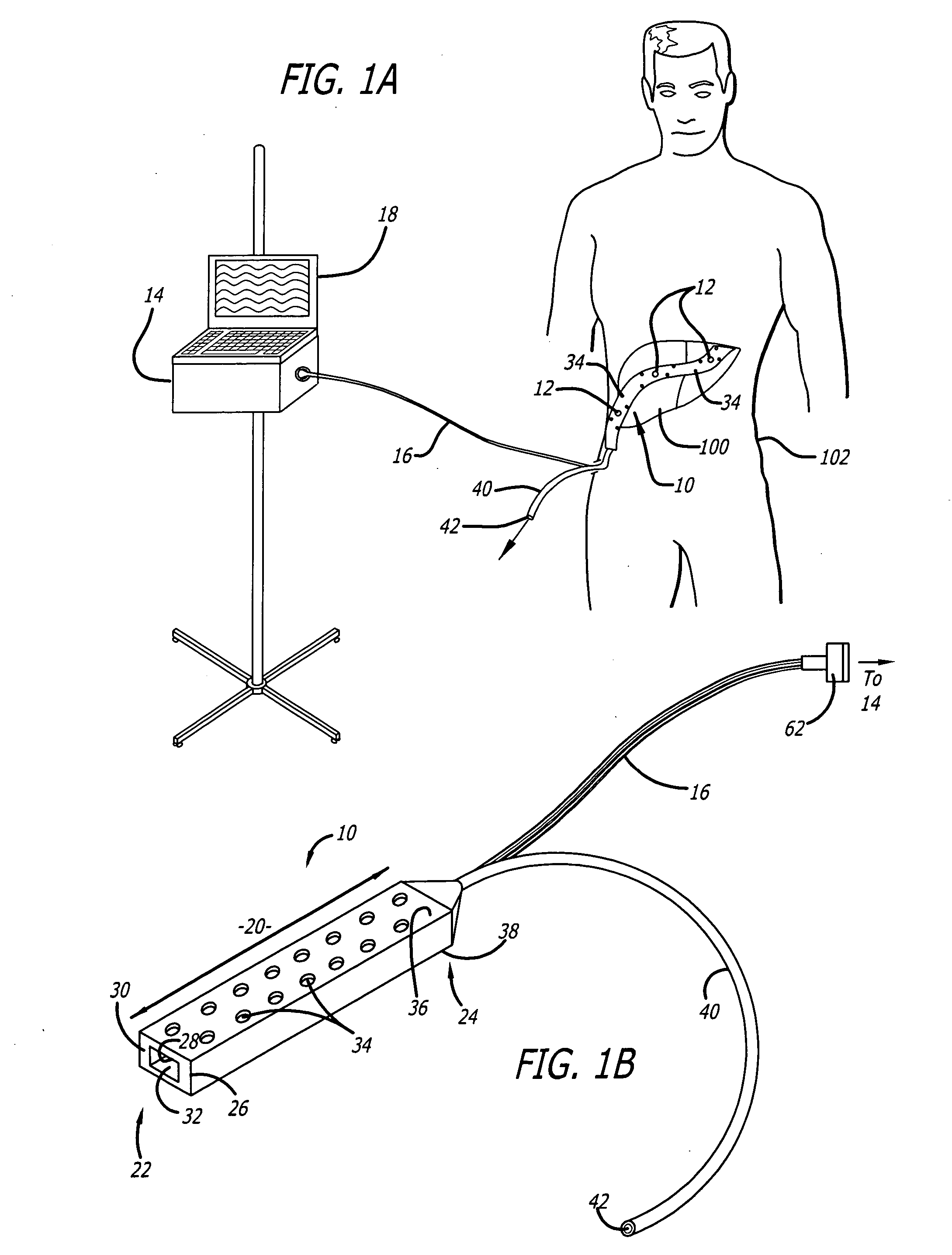However, these methods can be disadvantageous.
An invasive examination may cause discomfort and
risk of infection to the patient, and the information obtained either through direct inspection or indirectly via blood or radiological analysis, may be relevant only to the time at which the procedure is performed, and examination may render only indirect information about the
physiological condition of the organ.
Surgical complications, such as vascular complications, may disrupt adequate
oxygen circulation to the tissue, which is critical to
organ function and survival.
Unfortunately, these blood tests reflect liver condition only at the time the blood sample is drawn, and changes in these laboratory values can often be detected only after significant
organ damage has already occurred, permitting a limited opportunity for intervention by the physician to improve the condition of the organ or find a replacement organ in case of
transplantation for the patient.
However, these techniques can be difficult to successfully apply to
continuous monitoring of organ condition, and may provide only qualitative or indirect information regarding a condition, and / or may provide information about only a small segment of an organ.
These methods can lack the sensitivity and the resolution necessary for assessing hepatic
microcirculation.
Contrast sonography has been applied for qualitative assessment of blood
perfusion in the microvasculature, but its potential for quantitative measurement is still unclear.
Although sonography can be performed at bedside, it is neither sensitive nor specific, and does not indicate the actual
tissue oxygenation.
The test cannot be performed at bedside (as in Doppler
Ultrasonography) and requires moving critical ill patient to the
radiology suite, and the side effects are also higher in these sick patients.
However, these methods may not be sufficiently sensitive to obviate angiographic assessment, as described above.
Further, these methods can also be limited in their ability to measure blood
perfusion in microvasculature of the tissue.
By the time larger vessels are visibly impaired, the organ may have already undergone significant
tissue damage.
Further, these methods may be invasive in requiring the infusion of dye to which patients may react.
LDF is also limited in its application due to the short
depth of penetration and the large spatiotemporal variations of the
signal obtained.
Therefore, this technique may not reflect information regarding a broad geography of the tissue, and large variations may occur in recordings from different areas, in
spite of tissue conditions being similar between the regions.
This can lead to a false
perfusion measurement that is higher than the actual perfusion away from the probe.
The latter source of error may not be corrected by calibration because the degree of
vasodilation per temperature rise may vary between patients and may depend on many factors including administered drugs.
Thermodilution techniques may also be disadvantageous at least in requiring the
insertion of
catheter probes into an organ, which can become impractical when multiple probes are to be used.
Perfusion detection techniques such as LDF and thermodilution have an additional common inherent limitation.
Hence, monitoring the hepatic perfusion only would be a misleading measure of
ischemia.
Further, this critical demand-availability balance can be easily disturbed due to immunogenic and / or
drug reactions, therefore monitoring of
oxygenation levels is important in monitoring tissue condition.
However, this technique may not have been applied clinically due to several concerns.
First, the
fluorescence of NADH can be strongly modulated by the optical absorption of tissue
hemoglobin, and the absorption of
hemoglobin varies with its state of
oxygenation, which can complicate the analysis of the data.
These modulations can
mask the actual intensity of NADH
fluorescence thereby causing inaccuracies in the evaluation of
ischemia.
Therefore, it may not be possible to continuously monitor the same position on the organ for a prolonged period of time (i.e., more than 24 hours).
The increased pressure in the
abdomen may also lead to a decrease in the venous returns to the heart, therefore, affecting the
cardiac output and the perfusion to all organs / tissues leading to a decrease in
oxygen delivery.
However, once a critical point is reached, organs may suddenly fail, which may be irreversible in certain conditions and lead to rapid deterioration of multiple organs and potentially death.
Current methods of measuring
abdominal pressure may carry significant errors due to direct personal intervention, lack of reproducibility and challenges related to the injury itself.
As discussed above, each of these methods has significant technical disadvantages to monitoring tissue condition.
Further, each of these methods can also be cumbersome and expensive for bedside operation due to the size of the apparatus and cost associated with staff administering these methods, and unsuitable for
continuous monitoring of tissue conditions.
 Login to View More
Login to View More  Login to View More
Login to View More 


